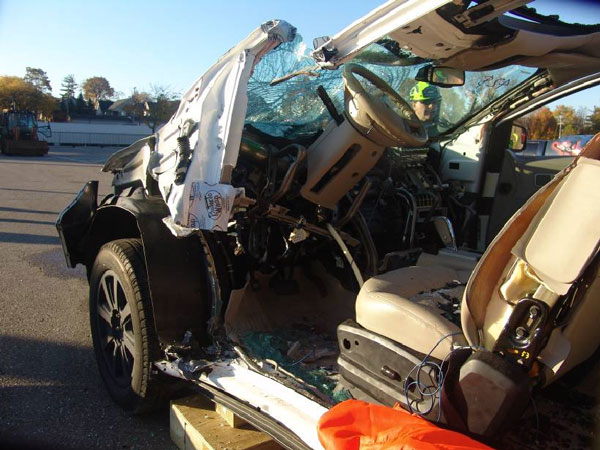By Dave Dalrymple
Dashboard displacement in today’s vehicles can be a difficult situation to manage. Although our tools today have increased power and capabilities, the vehicles we deal with usually leap-frog past the tool‘s ability to manage tasks with ease. With this in mind, firefighters need to constantly look at ways to defeat vehicles to enhance our patient’s outcome.
One of the tool evolutions that has changed over the recent past is dash displacement. Moving dashes has been increasingly problematic as vehicle construction methodology has changed and evolved. One of the safety features of today’s vehicles is their ability to readily absorb crash energy and dissipate it and/or redistribute it throughout the vehicle’s structure. Although this saves lives and helps reduce injuries, think how this principle will affect our tool operations.
The addition of dash reinforcement beam has made for difficult relocation or space-making, but then the added issue of energy absorption makes “traditional” dash roll evolutions problematic. Dash-lifting evolutions make for better solutions in today’s vehicles, but even these tool operations can be difficult if the vehicle is damaged severely (or even depending on the vehicle’s make). To make these dash displacement operations work better and give the rescuer the space needed, we need to add additional strategic cutting into the mix.

As part of our strategic cutting, create a vertical relief cut into the energy absorption or crush/crumple zone. This vertical relief cut allows us to isolate the dash when used in conjunction with the cuts of a dash displacement evolution. This isolation gives us the ability to displace just the dash/firewall area without “fighting” the rest of the vehicle structure. Where do we place these cuts? Well, first off we should be working on nose of the vehicle, on the same side as the patient that is being extricated. The cut should be placed past the vehicle’s suspension or toward the passenger compartment. This cut allows the dash when either lifted or rolled to pivot or hinge and prevents the vehicle structure from impeding displacement.
Our cut needs to be little wider, as well, so we do not “pinch” the crush zone and bind it up. This evolution is effective, however, if we do some additional strategic cuts and/or spreads we can make our dash evolutions and our door displacements easier, as well.

So how do you get to this crush or crumple zone? Basically, you must remove or dipslace the fender.
In a fender-strip evolution, displace the fender. Starting at the point where the fender, door, and A post meet, place your power hydraulic spreader tips and begin a spreading operation. This spreading motion will control the movement of the fender out and away from the vehicle. This will directly expose the crush zone as well as the door hinges and the wiring knockout hole in the dash area. Having all these items exposed will speed up your tool access for other displacement evolutions and make your vertical relief cut easier.
Another way to accomplish this is a fender-peel evolution. Reach into the fender well and find the vehicle’s front suspension. Take your power hydraulic cutter and make a vertical cut inline with the suspension, just cutting the fender. Then make another cut horizontally near the bottom of the fender, close to the base of the A post and the rocker panel. Then grab the fender above the horizontal cut and pull it up vertically and bend it over the hood to move it out of our way. A note of caution: some vehicles have reinforcement straps attaching the fender to the vehicle’s body, so they might need to be cut, too. The fender peel also exposes the crush zone; door hinges, and dash wiring knockout hole.

Use caution when working around the vehicle‘s suspension in all these evolutions. It is bad to cut, crush, or squeeze the vehicle’s suspension components. Also, use caution when making your vertical relief cut; if you cut through the hood area, many vehicles today use gas piston struts to assist with lifting the hood and hold it up. Use the same precautions as when cutting through the hatch area in reference to gas struts.
Although seeming minor in the grand scheme of the extrication process, fender evolutions play an increasingly important role in our space-making operations. As vehicle technology impacts us on the street, firefighters will be doing more dash displacements than ever before. Although learning the dash roll evolution is important because of vehicle construction considerations, today the dash lift is a better choice for displacing the dash. Use the vehicle’s technology to help you, the rescuer, rather than have it work against you. It’s all about how you go about doing this evolution and how and where you cut. The simple things make all the difference today. Brute force doesn’t cut it (no pun intended) any longer!
DAVID DALRYMPLE is a career EMS provider for the RWJUH Emergency Medical Services in New Brunswick, New Jersey, and a volunteer firefighter/EMT/rescue technician for Clinton (NJ) EMS/Rescue. He has been actively involved with emergency services for 27 years. He is the education chair of the Transportation Emergency Rescue Committee-US (TERC), is a certified international level extrication assessor, and serves on the Expert Technical Advisory Board of the IETRI as their road traffic accident advisor. Certified as a NJ fire service instructor, he has been teaching transportation rescue topics for more than 16 years. He is the executive educator for Roadway Rescue LLC, an educational team for transportation rescue training. He is an ICET (Netherlands) certified registered International SAVER instructor. He writes on “Extrication Tactics“ for Fire Engineering and contributed to Fire Engineering‘s Handbook for Firefighter I and II (2009). He received the 2007 Harvey Grant award for excellence in rescue education. He is featured in “Training Minutes“ on vehicle extrication on fireengineering.com.

